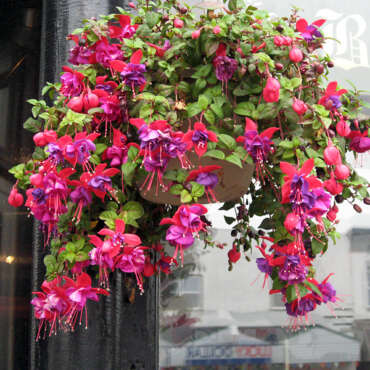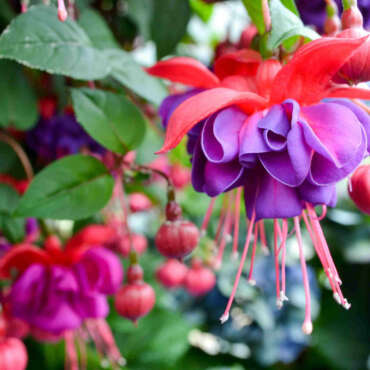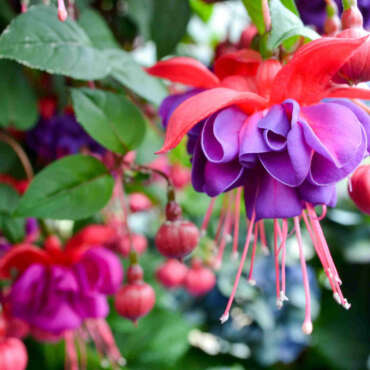Product Description
Fuchsia | 11″ – Hanging Baskets | Red / Purple
Hybrid fuchsias, with their petticoated, poodly pom-pom flowers, just might be the horticultural definition of gaudy. How many other plants can you think of that have their names pinned on a color (especially one so vivid)? Of course, if the numbers mean anything (10,000 named fuchsia hybrids with millions sold each year), my opinion is certainly in the minority. But when it comes to plants, what excites me the most is a simpler, more subtle beauty—like that possessed by species fuchsias, parents of those flashy hybrids.
Appeal
Dainty ballerina flowers of red, pink, white, lavender or yellow perch like jewels on trailing or arching stems, making them perfect for containers and hanging baskets. Where climate permits, plants grown in the ground can develop into shrubs covered with these delicate beauties or even work as groundcovers.
Zones
Most fuchsia species are native to well-watered tropical forest regions of Central and South America, with a few found in New Zealand and Tahiti. In cultivation, the plants thrive outdoors in cool-summered, frost-free climates, such as Northern California, the Pacific Northwest and the United Kingdom, where fuchsia shows are a regular summertime event. In cold-winter climates fuchsias can be treated as annuals, or potted plants can be stored dormant in a cool basement or garage, or wintered over in greenhouses.
Exposure
Summer heat often spells doom for the plants, which is why that basket of hanging fuchsias purchased on Mother’s Day often poops out by July. By providing dappled shade and protection from drying winds, and by paying attention to watering and misting, gardeners in hot climates can sometimes cajole the plants into surviving, if not thriving.
Soil
Whether grown in the ground or in containers, fuchsias benefit from a well-drained soil and a weekly feeding with half-strength water-soluble fertilizer.
Care
Fuchsias can be grown from softwood tip cuttings; rooting time varies from two to four weeks. Cuttings taken from the more vigorous species can grow to blooming size in a single season. Some species can also easily be grown from seeds, which the plants produce in the attractive berries that follow the flowers. Many species have strong resistance to the fuchsia gall mite, a microscopic insect that deforms the leaves and flowers of many hybrid varieties. Difficult to control without strong pesticides, the mite is especially pernicious on the West Coast of the United States. Aphids can also deform fuchsia growth, but being visible to the naked eye, these pests are easier to control.
Information from www.gardendesign.com
Specifications
- Weight: 15 lb
- >>: Colors are approximate



